Leadership for Quality & Safety in Healthcare Assignment
VerifiedAdded on 2022/09/16
|9
|2373
|13
Homework Assignment
AI Summary
This assignment delves into the critical aspects of quality and safety within the healthcare sector, addressing key concepts such as patient safety, risk management, and the importance of a robust safety culture. It explores the ethical principles underpinning patient care, emphasizing the roles of justice, beneficence, and non-maleficence. The assignment also examines the tools and strategies for effective risk management, including communication, incident reporting, and patient satisfaction surveys. Furthermore, it differentiates between clinical governance and clinical leadership, highlighting their respective roles in ensuring high standards of care. The importance of effective communication among healthcare professionals is underscored as a cornerstone for accurate patient assessment, care planning, and the prevention of errors. The assignment references various studies and surveys to support its analysis, providing a comprehensive overview of the multifaceted nature of quality and safety in healthcare.
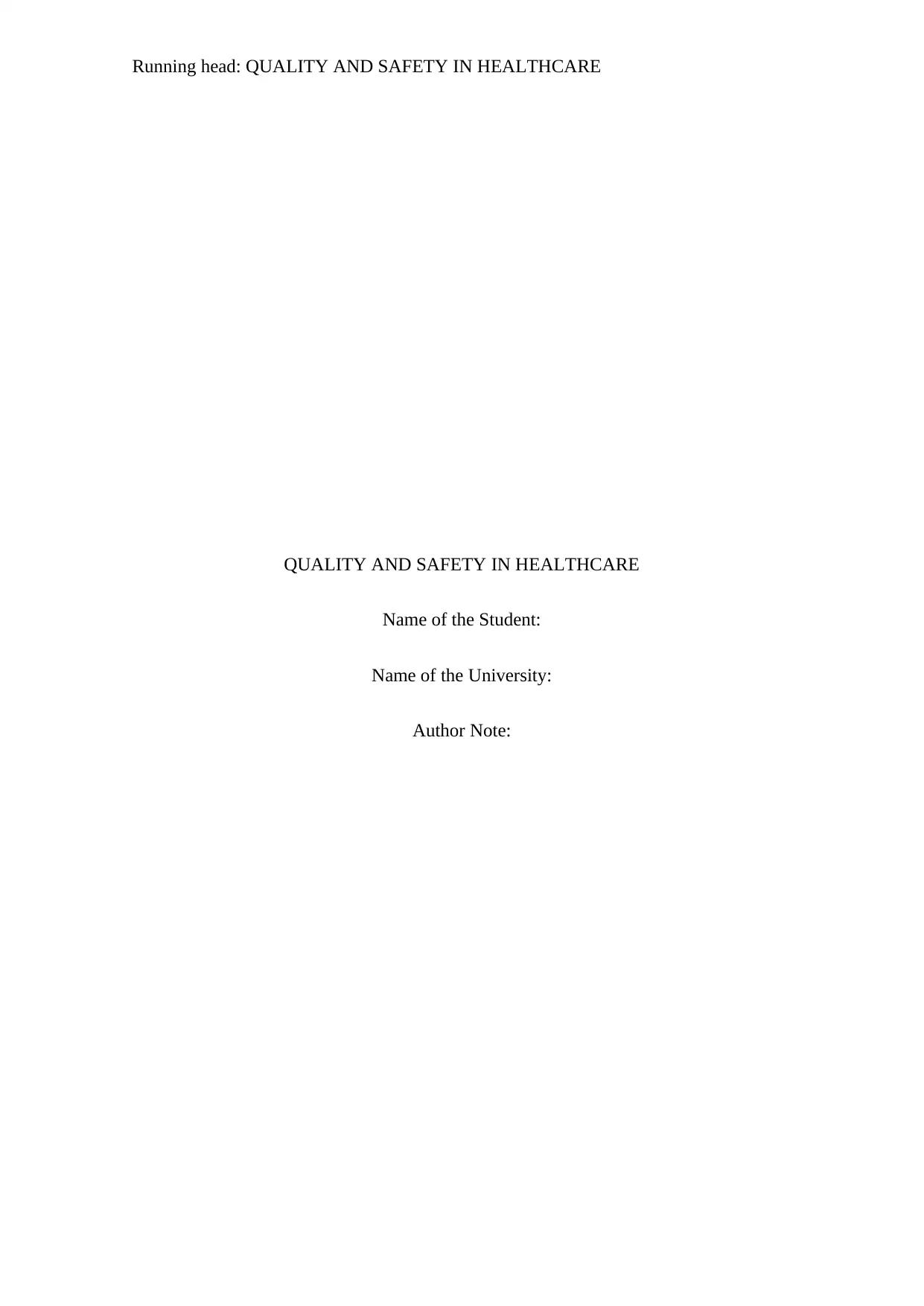
Running head: QUALITY AND SAFETY IN HEALTHCARE
QUALITY AND SAFETY IN HEALTHCARE
Name of the Student:
Name of the University:
Author Note:
QUALITY AND SAFETY IN HEALTHCARE
Name of the Student:
Name of the University:
Author Note:
Paraphrase This Document
Need a fresh take? Get an instant paraphrase of this document with our AI Paraphraser
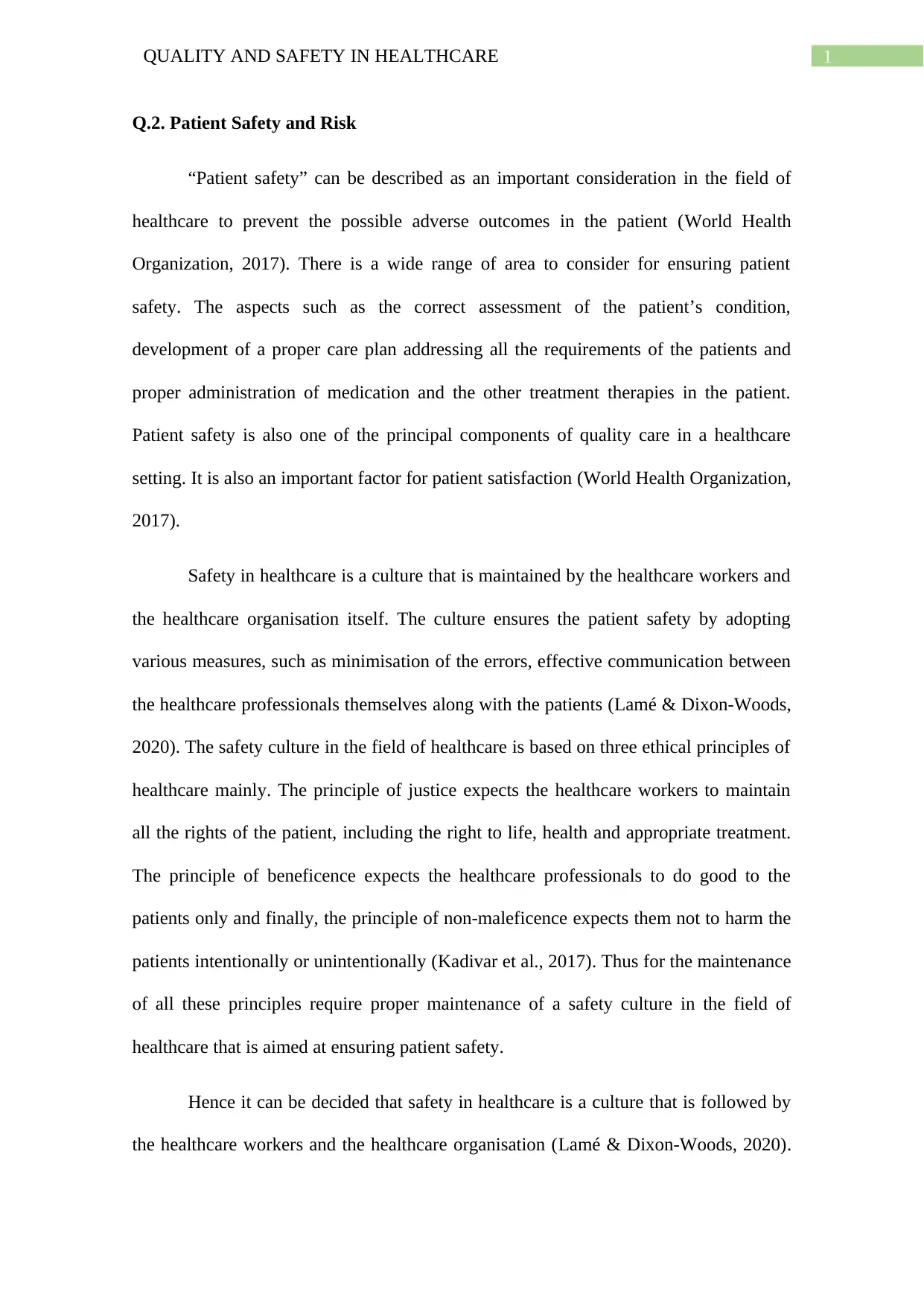
1QUALITY AND SAFETY IN HEALTHCARE
Q.2. Patient Safety and Risk
“Patient safety” can be described as an important consideration in the field of
healthcare to prevent the possible adverse outcomes in the patient (World Health
Organization, 2017). There is a wide range of area to consider for ensuring patient
safety. The aspects such as the correct assessment of the patient’s condition,
development of a proper care plan addressing all the requirements of the patients and
proper administration of medication and the other treatment therapies in the patient.
Patient safety is also one of the principal components of quality care in a healthcare
setting. It is also an important factor for patient satisfaction (World Health Organization,
2017).
Safety in healthcare is a culture that is maintained by the healthcare workers and
the healthcare organisation itself. The culture ensures the patient safety by adopting
various measures, such as minimisation of the errors, effective communication between
the healthcare professionals themselves along with the patients (Lamé & Dixon-Woods,
2020). The safety culture in the field of healthcare is based on three ethical principles of
healthcare mainly. The principle of justice expects the healthcare workers to maintain
all the rights of the patient, including the right to life, health and appropriate treatment.
The principle of beneficence expects the healthcare professionals to do good to the
patients only and finally, the principle of non-maleficence expects them not to harm the
patients intentionally or unintentionally (Kadivar et al., 2017). Thus for the maintenance
of all these principles require proper maintenance of a safety culture in the field of
healthcare that is aimed at ensuring patient safety.
Hence it can be decided that safety in healthcare is a culture that is followed by
the healthcare workers and the healthcare organisation (Lamé & Dixon-Woods, 2020).
Q.2. Patient Safety and Risk
“Patient safety” can be described as an important consideration in the field of
healthcare to prevent the possible adverse outcomes in the patient (World Health
Organization, 2017). There is a wide range of area to consider for ensuring patient
safety. The aspects such as the correct assessment of the patient’s condition,
development of a proper care plan addressing all the requirements of the patients and
proper administration of medication and the other treatment therapies in the patient.
Patient safety is also one of the principal components of quality care in a healthcare
setting. It is also an important factor for patient satisfaction (World Health Organization,
2017).
Safety in healthcare is a culture that is maintained by the healthcare workers and
the healthcare organisation itself. The culture ensures the patient safety by adopting
various measures, such as minimisation of the errors, effective communication between
the healthcare professionals themselves along with the patients (Lamé & Dixon-Woods,
2020). The safety culture in the field of healthcare is based on three ethical principles of
healthcare mainly. The principle of justice expects the healthcare workers to maintain
all the rights of the patient, including the right to life, health and appropriate treatment.
The principle of beneficence expects the healthcare professionals to do good to the
patients only and finally, the principle of non-maleficence expects them not to harm the
patients intentionally or unintentionally (Kadivar et al., 2017). Thus for the maintenance
of all these principles require proper maintenance of a safety culture in the field of
healthcare that is aimed at ensuring patient safety.
Hence it can be decided that safety in healthcare is a culture that is followed by
the healthcare workers and the healthcare organisation (Lamé & Dixon-Woods, 2020).
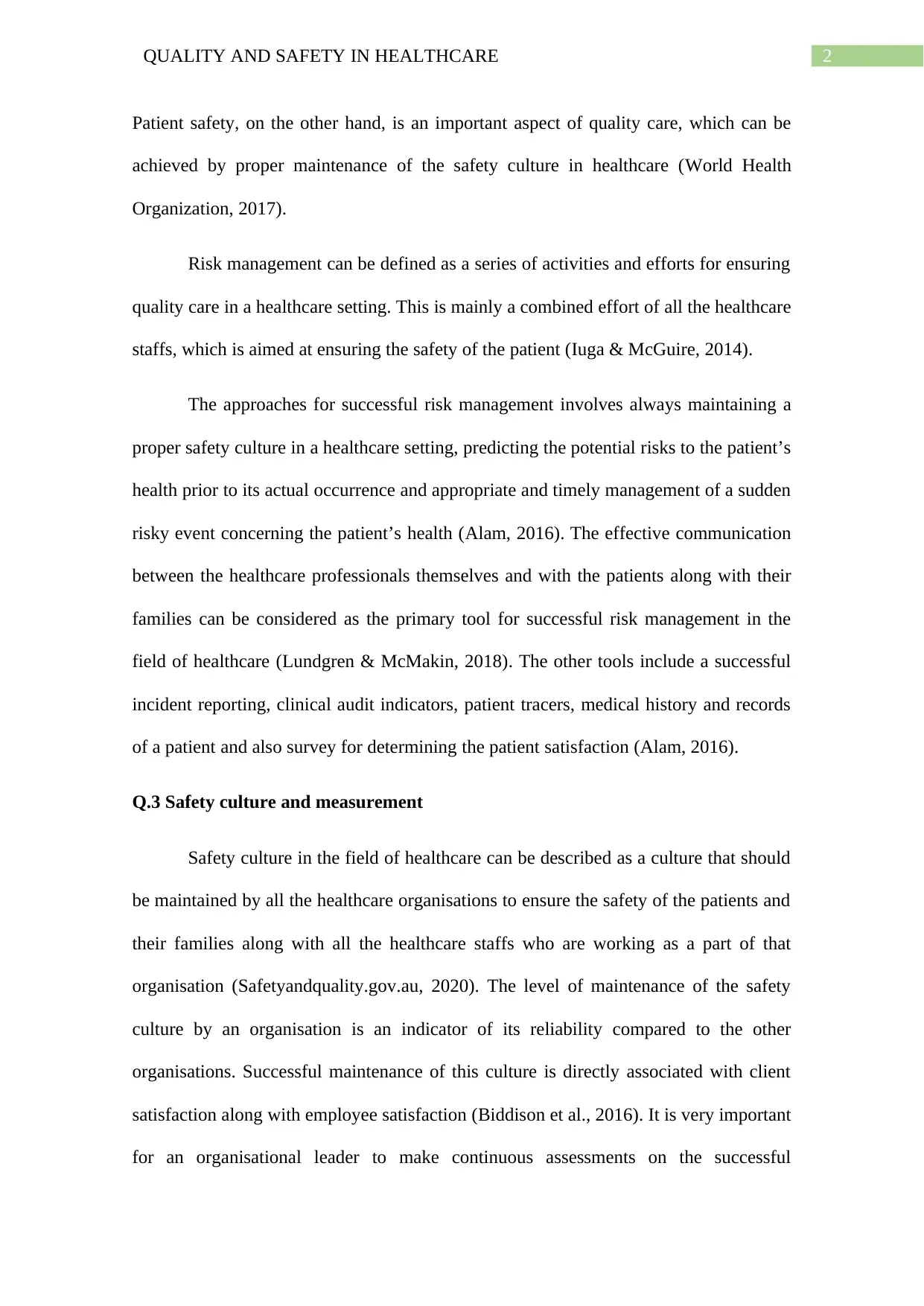
2QUALITY AND SAFETY IN HEALTHCARE
Patient safety, on the other hand, is an important aspect of quality care, which can be
achieved by proper maintenance of the safety culture in healthcare (World Health
Organization, 2017).
Risk management can be defined as a series of activities and efforts for ensuring
quality care in a healthcare setting. This is mainly a combined effort of all the healthcare
staffs, which is aimed at ensuring the safety of the patient (Iuga & McGuire, 2014).
The approaches for successful risk management involves always maintaining a
proper safety culture in a healthcare setting, predicting the potential risks to the patient’s
health prior to its actual occurrence and appropriate and timely management of a sudden
risky event concerning the patient’s health (Alam, 2016). The effective communication
between the healthcare professionals themselves and with the patients along with their
families can be considered as the primary tool for successful risk management in the
field of healthcare (Lundgren & McMakin, 2018). The other tools include a successful
incident reporting, clinical audit indicators, patient tracers, medical history and records
of a patient and also survey for determining the patient satisfaction (Alam, 2016).
Q.3 Safety culture and measurement
Safety culture in the field of healthcare can be described as a culture that should
be maintained by all the healthcare organisations to ensure the safety of the patients and
their families along with all the healthcare staffs who are working as a part of that
organisation (Safetyandquality.gov.au, 2020). The level of maintenance of the safety
culture by an organisation is an indicator of its reliability compared to the other
organisations. Successful maintenance of this culture is directly associated with client
satisfaction along with employee satisfaction (Biddison et al., 2016). It is very important
for an organisational leader to make continuous assessments on the successful
Patient safety, on the other hand, is an important aspect of quality care, which can be
achieved by proper maintenance of the safety culture in healthcare (World Health
Organization, 2017).
Risk management can be defined as a series of activities and efforts for ensuring
quality care in a healthcare setting. This is mainly a combined effort of all the healthcare
staffs, which is aimed at ensuring the safety of the patient (Iuga & McGuire, 2014).
The approaches for successful risk management involves always maintaining a
proper safety culture in a healthcare setting, predicting the potential risks to the patient’s
health prior to its actual occurrence and appropriate and timely management of a sudden
risky event concerning the patient’s health (Alam, 2016). The effective communication
between the healthcare professionals themselves and with the patients along with their
families can be considered as the primary tool for successful risk management in the
field of healthcare (Lundgren & McMakin, 2018). The other tools include a successful
incident reporting, clinical audit indicators, patient tracers, medical history and records
of a patient and also survey for determining the patient satisfaction (Alam, 2016).
Q.3 Safety culture and measurement
Safety culture in the field of healthcare can be described as a culture that should
be maintained by all the healthcare organisations to ensure the safety of the patients and
their families along with all the healthcare staffs who are working as a part of that
organisation (Safetyandquality.gov.au, 2020). The level of maintenance of the safety
culture by an organisation is an indicator of its reliability compared to the other
organisations. Successful maintenance of this culture is directly associated with client
satisfaction along with employee satisfaction (Biddison et al., 2016). It is very important
for an organisational leader to make continuous assessments on the successful
⊘ This is a preview!⊘
Do you want full access?
Subscribe today to unlock all pages.

Trusted by 1+ million students worldwide
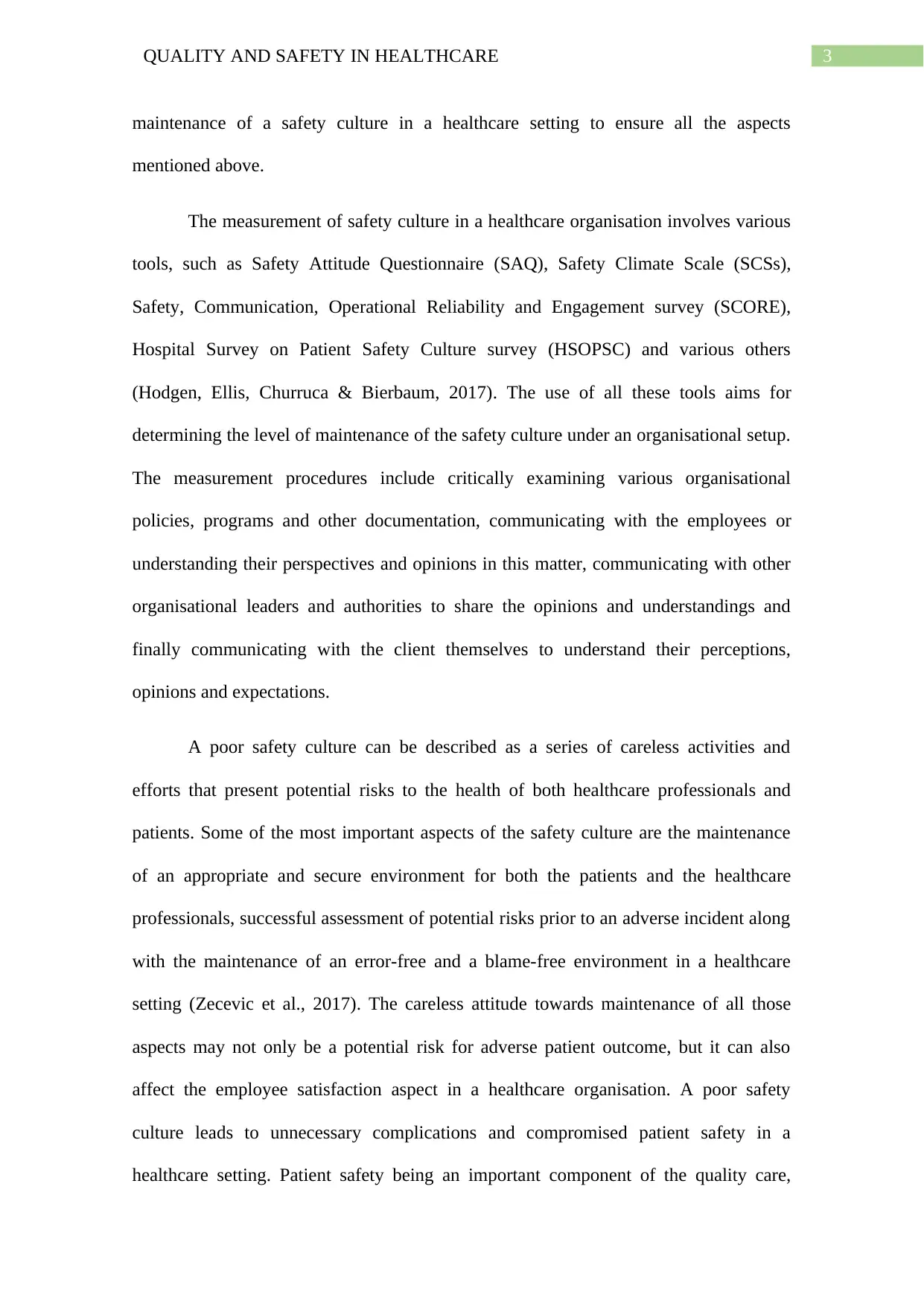
3QUALITY AND SAFETY IN HEALTHCARE
maintenance of a safety culture in a healthcare setting to ensure all the aspects
mentioned above.
The measurement of safety culture in a healthcare organisation involves various
tools, such as Safety Attitude Questionnaire (SAQ), Safety Climate Scale (SCSs),
Safety, Communication, Operational Reliability and Engagement survey (SCORE),
Hospital Survey on Patient Safety Culture survey (HSOPSC) and various others
(Hodgen, Ellis, Churruca & Bierbaum, 2017). The use of all these tools aims for
determining the level of maintenance of the safety culture under an organisational setup.
The measurement procedures include critically examining various organisational
policies, programs and other documentation, communicating with the employees or
understanding their perspectives and opinions in this matter, communicating with other
organisational leaders and authorities to share the opinions and understandings and
finally communicating with the client themselves to understand their perceptions,
opinions and expectations.
A poor safety culture can be described as a series of careless activities and
efforts that present potential risks to the health of both healthcare professionals and
patients. Some of the most important aspects of the safety culture are the maintenance
of an appropriate and secure environment for both the patients and the healthcare
professionals, successful assessment of potential risks prior to an adverse incident along
with the maintenance of an error-free and a blame-free environment in a healthcare
setting (Zecevic et al., 2017). The careless attitude towards maintenance of all those
aspects may not only be a potential risk for adverse patient outcome, but it can also
affect the employee satisfaction aspect in a healthcare organisation. A poor safety
culture leads to unnecessary complications and compromised patient safety in a
healthcare setting. Patient safety being an important component of the quality care,
maintenance of a safety culture in a healthcare setting to ensure all the aspects
mentioned above.
The measurement of safety culture in a healthcare organisation involves various
tools, such as Safety Attitude Questionnaire (SAQ), Safety Climate Scale (SCSs),
Safety, Communication, Operational Reliability and Engagement survey (SCORE),
Hospital Survey on Patient Safety Culture survey (HSOPSC) and various others
(Hodgen, Ellis, Churruca & Bierbaum, 2017). The use of all these tools aims for
determining the level of maintenance of the safety culture under an organisational setup.
The measurement procedures include critically examining various organisational
policies, programs and other documentation, communicating with the employees or
understanding their perspectives and opinions in this matter, communicating with other
organisational leaders and authorities to share the opinions and understandings and
finally communicating with the client themselves to understand their perceptions,
opinions and expectations.
A poor safety culture can be described as a series of careless activities and
efforts that present potential risks to the health of both healthcare professionals and
patients. Some of the most important aspects of the safety culture are the maintenance
of an appropriate and secure environment for both the patients and the healthcare
professionals, successful assessment of potential risks prior to an adverse incident along
with the maintenance of an error-free and a blame-free environment in a healthcare
setting (Zecevic et al., 2017). The careless attitude towards maintenance of all those
aspects may not only be a potential risk for adverse patient outcome, but it can also
affect the employee satisfaction aspect in a healthcare organisation. A poor safety
culture leads to unnecessary complications and compromised patient safety in a
healthcare setting. Patient safety being an important component of the quality care,
Paraphrase This Document
Need a fresh take? Get an instant paraphrase of this document with our AI Paraphraser
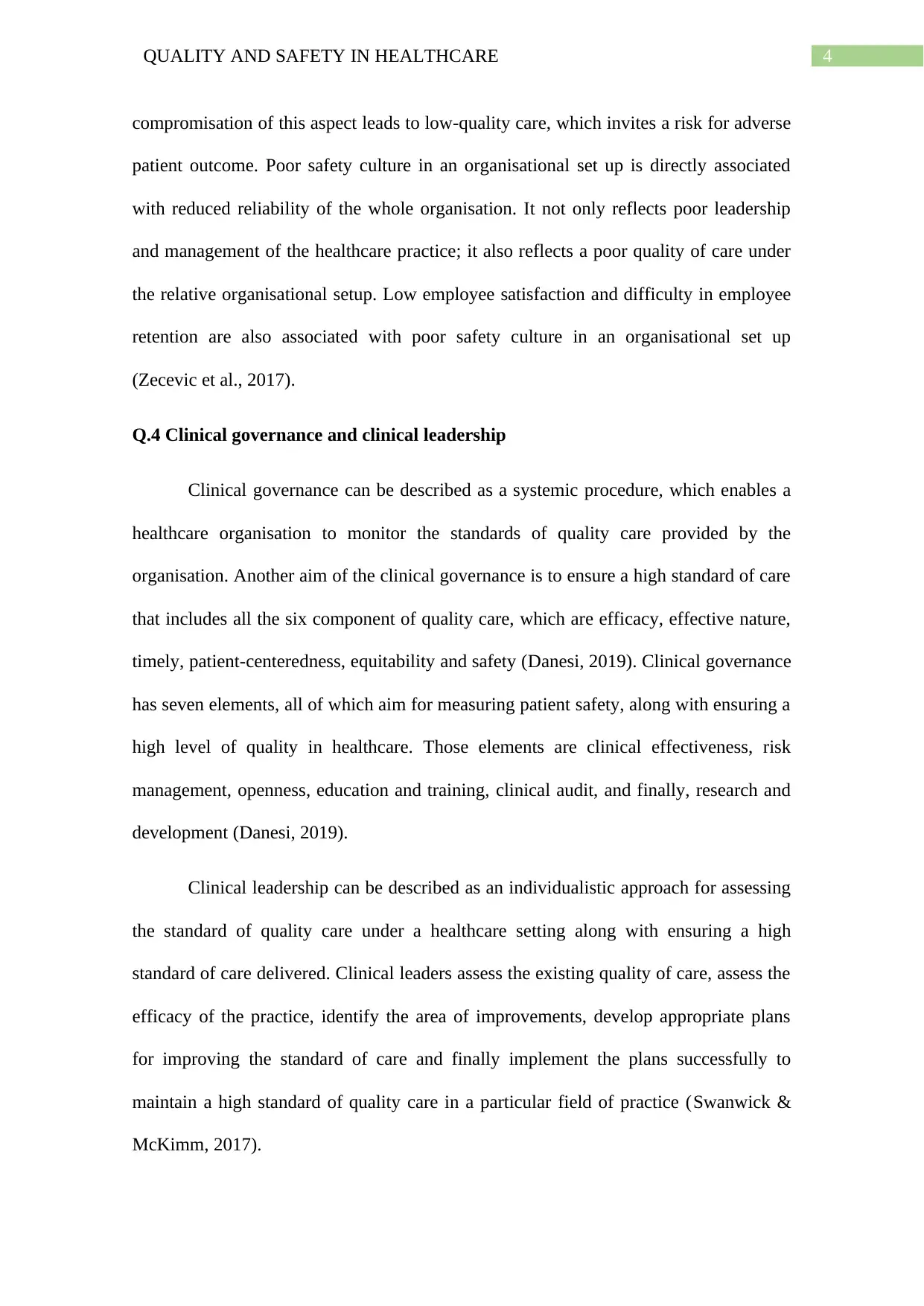
4QUALITY AND SAFETY IN HEALTHCARE
compromisation of this aspect leads to low-quality care, which invites a risk for adverse
patient outcome. Poor safety culture in an organisational set up is directly associated
with reduced reliability of the whole organisation. It not only reflects poor leadership
and management of the healthcare practice; it also reflects a poor quality of care under
the relative organisational setup. Low employee satisfaction and difficulty in employee
retention are also associated with poor safety culture in an organisational set up
(Zecevic et al., 2017).
Q.4 Clinical governance and clinical leadership
Clinical governance can be described as a systemic procedure, which enables a
healthcare organisation to monitor the standards of quality care provided by the
organisation. Another aim of the clinical governance is to ensure a high standard of care
that includes all the six component of quality care, which are efficacy, effective nature,
timely, patient-centeredness, equitability and safety (Danesi, 2019). Clinical governance
has seven elements, all of which aim for measuring patient safety, along with ensuring a
high level of quality in healthcare. Those elements are clinical effectiveness, risk
management, openness, education and training, clinical audit, and finally, research and
development (Danesi, 2019).
Clinical leadership can be described as an individualistic approach for assessing
the standard of quality care under a healthcare setting along with ensuring a high
standard of care delivered. Clinical leaders assess the existing quality of care, assess the
efficacy of the practice, identify the area of improvements, develop appropriate plans
for improving the standard of care and finally implement the plans successfully to
maintain a high standard of quality care in a particular field of practice (Swanwick &
McKimm, 2017).
compromisation of this aspect leads to low-quality care, which invites a risk for adverse
patient outcome. Poor safety culture in an organisational set up is directly associated
with reduced reliability of the whole organisation. It not only reflects poor leadership
and management of the healthcare practice; it also reflects a poor quality of care under
the relative organisational setup. Low employee satisfaction and difficulty in employee
retention are also associated with poor safety culture in an organisational set up
(Zecevic et al., 2017).
Q.4 Clinical governance and clinical leadership
Clinical governance can be described as a systemic procedure, which enables a
healthcare organisation to monitor the standards of quality care provided by the
organisation. Another aim of the clinical governance is to ensure a high standard of care
that includes all the six component of quality care, which are efficacy, effective nature,
timely, patient-centeredness, equitability and safety (Danesi, 2019). Clinical governance
has seven elements, all of which aim for measuring patient safety, along with ensuring a
high level of quality in healthcare. Those elements are clinical effectiveness, risk
management, openness, education and training, clinical audit, and finally, research and
development (Danesi, 2019).
Clinical leadership can be described as an individualistic approach for assessing
the standard of quality care under a healthcare setting along with ensuring a high
standard of care delivered. Clinical leaders assess the existing quality of care, assess the
efficacy of the practice, identify the area of improvements, develop appropriate plans
for improving the standard of care and finally implement the plans successfully to
maintain a high standard of quality care in a particular field of practice (Swanwick &
McKimm, 2017).
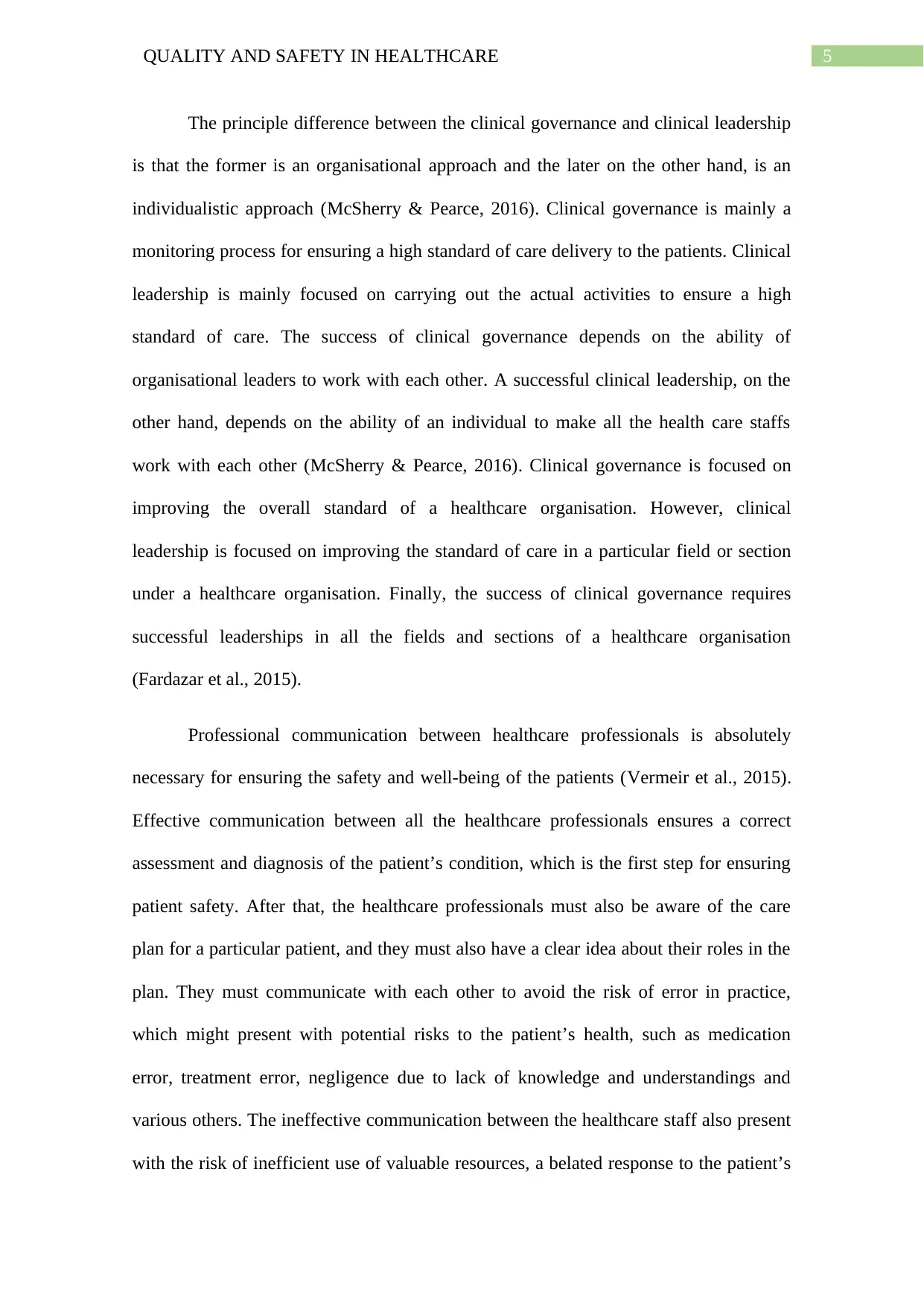
5QUALITY AND SAFETY IN HEALTHCARE
The principle difference between the clinical governance and clinical leadership
is that the former is an organisational approach and the later on the other hand, is an
individualistic approach (McSherry & Pearce, 2016). Clinical governance is mainly a
monitoring process for ensuring a high standard of care delivery to the patients. Clinical
leadership is mainly focused on carrying out the actual activities to ensure a high
standard of care. The success of clinical governance depends on the ability of
organisational leaders to work with each other. A successful clinical leadership, on the
other hand, depends on the ability of an individual to make all the health care staffs
work with each other (McSherry & Pearce, 2016). Clinical governance is focused on
improving the overall standard of a healthcare organisation. However, clinical
leadership is focused on improving the standard of care in a particular field or section
under a healthcare organisation. Finally, the success of clinical governance requires
successful leaderships in all the fields and sections of a healthcare organisation
(Fardazar et al., 2015).
Professional communication between healthcare professionals is absolutely
necessary for ensuring the safety and well-being of the patients (Vermeir et al., 2015).
Effective communication between all the healthcare professionals ensures a correct
assessment and diagnosis of the patient’s condition, which is the first step for ensuring
patient safety. After that, the healthcare professionals must also be aware of the care
plan for a particular patient, and they must also have a clear idea about their roles in the
plan. They must communicate with each other to avoid the risk of error in practice,
which might present with potential risks to the patient’s health, such as medication
error, treatment error, negligence due to lack of knowledge and understandings and
various others. The ineffective communication between the healthcare staff also present
with the risk of inefficient use of valuable resources, a belated response to the patient’s
The principle difference between the clinical governance and clinical leadership
is that the former is an organisational approach and the later on the other hand, is an
individualistic approach (McSherry & Pearce, 2016). Clinical governance is mainly a
monitoring process for ensuring a high standard of care delivery to the patients. Clinical
leadership is mainly focused on carrying out the actual activities to ensure a high
standard of care. The success of clinical governance depends on the ability of
organisational leaders to work with each other. A successful clinical leadership, on the
other hand, depends on the ability of an individual to make all the health care staffs
work with each other (McSherry & Pearce, 2016). Clinical governance is focused on
improving the overall standard of a healthcare organisation. However, clinical
leadership is focused on improving the standard of care in a particular field or section
under a healthcare organisation. Finally, the success of clinical governance requires
successful leaderships in all the fields and sections of a healthcare organisation
(Fardazar et al., 2015).
Professional communication between healthcare professionals is absolutely
necessary for ensuring the safety and well-being of the patients (Vermeir et al., 2015).
Effective communication between all the healthcare professionals ensures a correct
assessment and diagnosis of the patient’s condition, which is the first step for ensuring
patient safety. After that, the healthcare professionals must also be aware of the care
plan for a particular patient, and they must also have a clear idea about their roles in the
plan. They must communicate with each other to avoid the risk of error in practice,
which might present with potential risks to the patient’s health, such as medication
error, treatment error, negligence due to lack of knowledge and understandings and
various others. The ineffective communication between the healthcare staff also present
with the risk of inefficient use of valuable resources, a belated response to the patient’s
⊘ This is a preview!⊘
Do you want full access?
Subscribe today to unlock all pages.

Trusted by 1+ million students worldwide
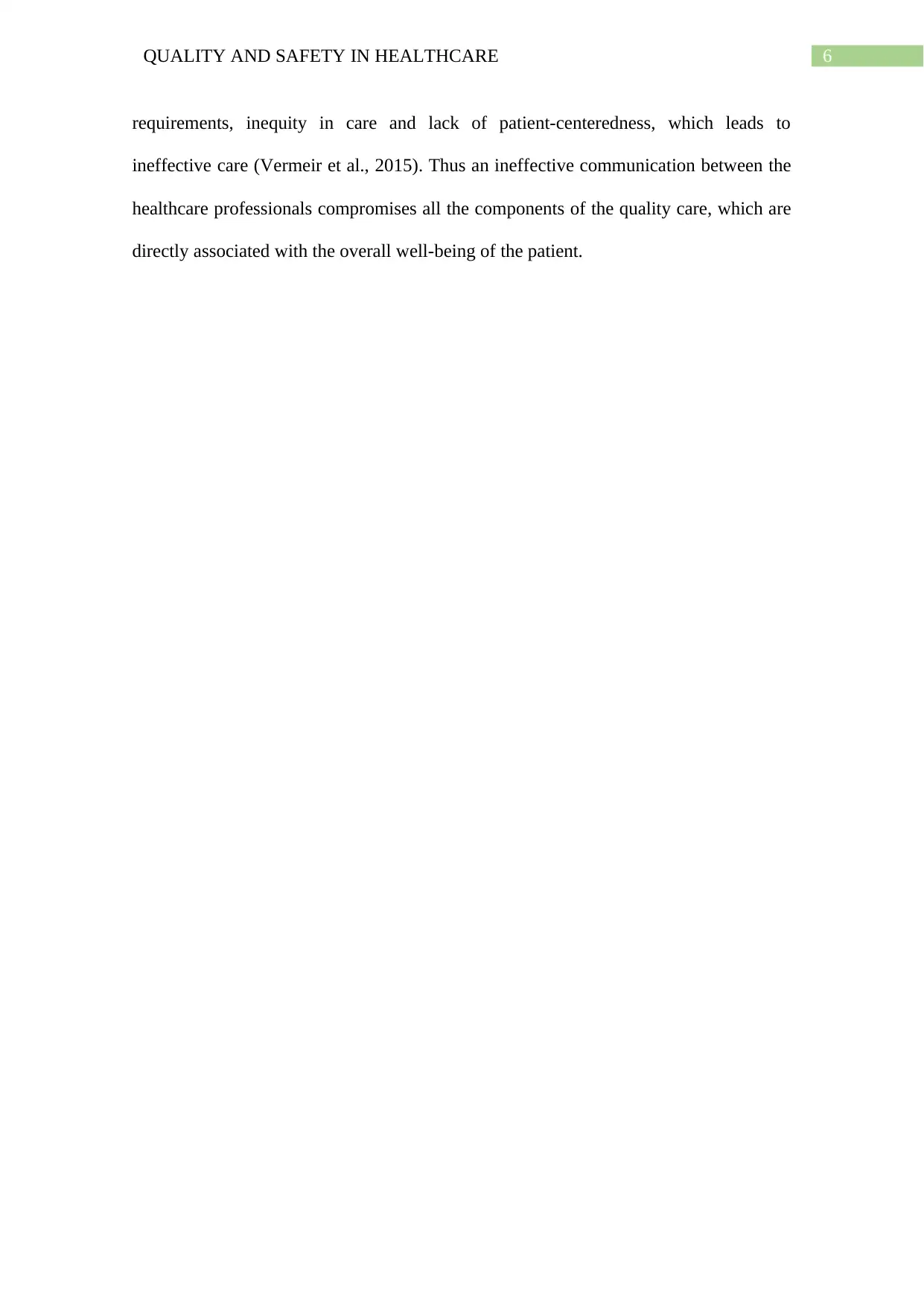
6QUALITY AND SAFETY IN HEALTHCARE
requirements, inequity in care and lack of patient-centeredness, which leads to
ineffective care (Vermeir et al., 2015). Thus an ineffective communication between the
healthcare professionals compromises all the components of the quality care, which are
directly associated with the overall well-being of the patient.
requirements, inequity in care and lack of patient-centeredness, which leads to
ineffective care (Vermeir et al., 2015). Thus an ineffective communication between the
healthcare professionals compromises all the components of the quality care, which are
directly associated with the overall well-being of the patient.
Paraphrase This Document
Need a fresh take? Get an instant paraphrase of this document with our AI Paraphraser
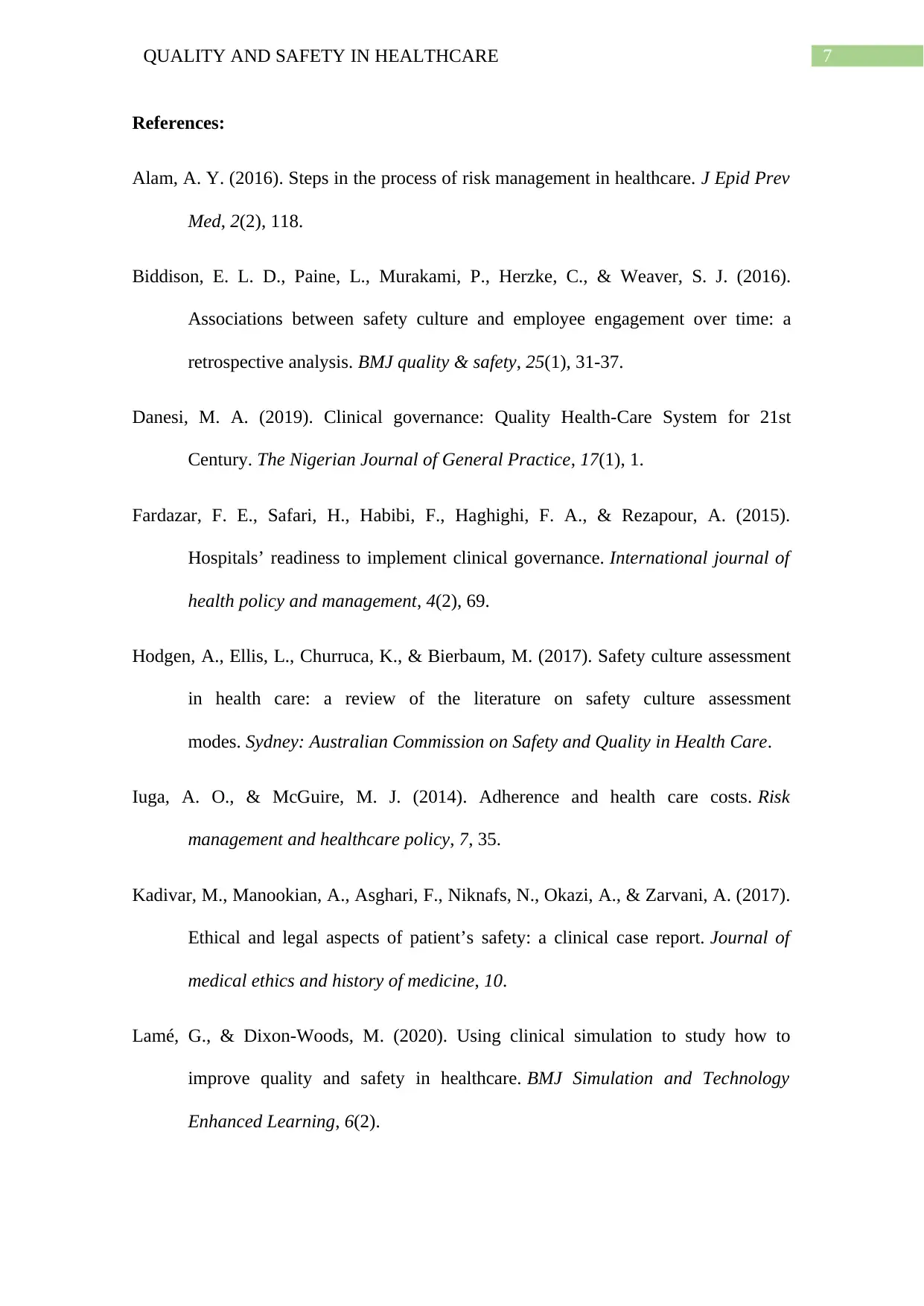
7QUALITY AND SAFETY IN HEALTHCARE
References:
Alam, A. Y. (2016). Steps in the process of risk management in healthcare. J Epid Prev
Med, 2(2), 118.
Biddison, E. L. D., Paine, L., Murakami, P., Herzke, C., & Weaver, S. J. (2016).
Associations between safety culture and employee engagement over time: a
retrospective analysis. BMJ quality & safety, 25(1), 31-37.
Danesi, M. A. (2019). Clinical governance: Quality Health-Care System for 21st
Century. The Nigerian Journal of General Practice, 17(1), 1.
Fardazar, F. E., Safari, H., Habibi, F., Haghighi, F. A., & Rezapour, A. (2015).
Hospitals’ readiness to implement clinical governance. International journal of
health policy and management, 4(2), 69.
Hodgen, A., Ellis, L., Churruca, K., & Bierbaum, M. (2017). Safety culture assessment
in health care: a review of the literature on safety culture assessment
modes. Sydney: Australian Commission on Safety and Quality in Health Care.
Iuga, A. O., & McGuire, M. J. (2014). Adherence and health care costs. Risk
management and healthcare policy, 7, 35.
Kadivar, M., Manookian, A., Asghari, F., Niknafs, N., Okazi, A., & Zarvani, A. (2017).
Ethical and legal aspects of patient’s safety: a clinical case report. Journal of
medical ethics and history of medicine, 10.
Lamé, G., & Dixon-Woods, M. (2020). Using clinical simulation to study how to
improve quality and safety in healthcare. BMJ Simulation and Technology
Enhanced Learning, 6(2).
References:
Alam, A. Y. (2016). Steps in the process of risk management in healthcare. J Epid Prev
Med, 2(2), 118.
Biddison, E. L. D., Paine, L., Murakami, P., Herzke, C., & Weaver, S. J. (2016).
Associations between safety culture and employee engagement over time: a
retrospective analysis. BMJ quality & safety, 25(1), 31-37.
Danesi, M. A. (2019). Clinical governance: Quality Health-Care System for 21st
Century. The Nigerian Journal of General Practice, 17(1), 1.
Fardazar, F. E., Safari, H., Habibi, F., Haghighi, F. A., & Rezapour, A. (2015).
Hospitals’ readiness to implement clinical governance. International journal of
health policy and management, 4(2), 69.
Hodgen, A., Ellis, L., Churruca, K., & Bierbaum, M. (2017). Safety culture assessment
in health care: a review of the literature on safety culture assessment
modes. Sydney: Australian Commission on Safety and Quality in Health Care.
Iuga, A. O., & McGuire, M. J. (2014). Adherence and health care costs. Risk
management and healthcare policy, 7, 35.
Kadivar, M., Manookian, A., Asghari, F., Niknafs, N., Okazi, A., & Zarvani, A. (2017).
Ethical and legal aspects of patient’s safety: a clinical case report. Journal of
medical ethics and history of medicine, 10.
Lamé, G., & Dixon-Woods, M. (2020). Using clinical simulation to study how to
improve quality and safety in healthcare. BMJ Simulation and Technology
Enhanced Learning, 6(2).
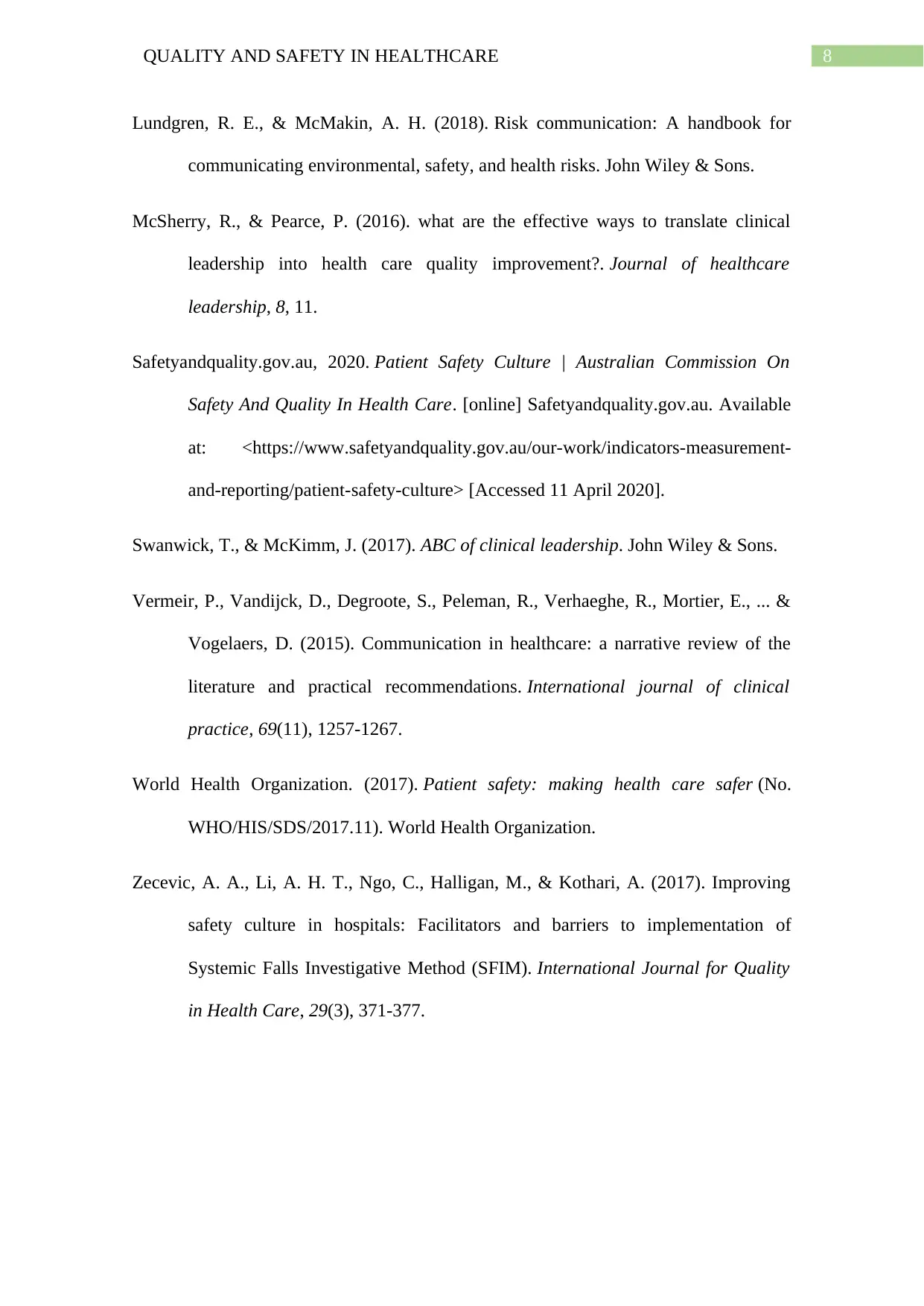
8QUALITY AND SAFETY IN HEALTHCARE
Lundgren, R. E., & McMakin, A. H. (2018). Risk communication: A handbook for
communicating environmental, safety, and health risks. John Wiley & Sons.
McSherry, R., & Pearce, P. (2016). what are the effective ways to translate clinical
leadership into health care quality improvement?. Journal of healthcare
leadership, 8, 11.
Safetyandquality.gov.au, 2020. Patient Safety Culture | Australian Commission On
Safety And Quality In Health Care. [online] Safetyandquality.gov.au. Available
at: <https://www.safetyandquality.gov.au/our-work/indicators-measurement-
and-reporting/patient-safety-culture> [Accessed 11 April 2020].
Swanwick, T., & McKimm, J. (2017). ABC of clinical leadership. John Wiley & Sons.
Vermeir, P., Vandijck, D., Degroote, S., Peleman, R., Verhaeghe, R., Mortier, E., ... &
Vogelaers, D. (2015). Communication in healthcare: a narrative review of the
literature and practical recommendations. International journal of clinical
practice, 69(11), 1257-1267.
World Health Organization. (2017). Patient safety: making health care safer (No.
WHO/HIS/SDS/2017.11). World Health Organization.
Zecevic, A. A., Li, A. H. T., Ngo, C., Halligan, M., & Kothari, A. (2017). Improving
safety culture in hospitals: Facilitators and barriers to implementation of
Systemic Falls Investigative Method (SFIM). International Journal for Quality
in Health Care, 29(3), 371-377.
Lundgren, R. E., & McMakin, A. H. (2018). Risk communication: A handbook for
communicating environmental, safety, and health risks. John Wiley & Sons.
McSherry, R., & Pearce, P. (2016). what are the effective ways to translate clinical
leadership into health care quality improvement?. Journal of healthcare
leadership, 8, 11.
Safetyandquality.gov.au, 2020. Patient Safety Culture | Australian Commission On
Safety And Quality In Health Care. [online] Safetyandquality.gov.au. Available
at: <https://www.safetyandquality.gov.au/our-work/indicators-measurement-
and-reporting/patient-safety-culture> [Accessed 11 April 2020].
Swanwick, T., & McKimm, J. (2017). ABC of clinical leadership. John Wiley & Sons.
Vermeir, P., Vandijck, D., Degroote, S., Peleman, R., Verhaeghe, R., Mortier, E., ... &
Vogelaers, D. (2015). Communication in healthcare: a narrative review of the
literature and practical recommendations. International journal of clinical
practice, 69(11), 1257-1267.
World Health Organization. (2017). Patient safety: making health care safer (No.
WHO/HIS/SDS/2017.11). World Health Organization.
Zecevic, A. A., Li, A. H. T., Ngo, C., Halligan, M., & Kothari, A. (2017). Improving
safety culture in hospitals: Facilitators and barriers to implementation of
Systemic Falls Investigative Method (SFIM). International Journal for Quality
in Health Care, 29(3), 371-377.
⊘ This is a preview!⊘
Do you want full access?
Subscribe today to unlock all pages.

Trusted by 1+ million students worldwide
1 out of 9
Related Documents
Your All-in-One AI-Powered Toolkit for Academic Success.
+13062052269
info@desklib.com
Available 24*7 on WhatsApp / Email
![[object Object]](/_next/static/media/star-bottom.7253800d.svg)
Unlock your academic potential
Copyright © 2020–2025 A2Z Services. All Rights Reserved. Developed and managed by ZUCOL.





